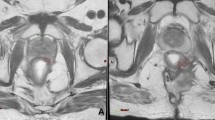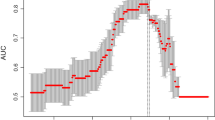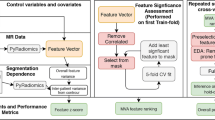Abstract
Purpose
The accurate prediction of treatment response in locally advanced rectal cancer (LARC) patients undergoing MRI-guided radiotherapy (MRIgRT) is essential for optimising treatment strategies. This multi-institutional study aimed to investigate the potential of radiomics in enhancing the predictive power of a known radiobiological parameter (Early Regression Index, ERITCP) to evaluate treatment response in LARC patients treated with MRIgRT.
Methods
Patients from three international sites were included and divided into training and validation sets. 0.35 T T2*/T1-weighted MR images were acquired during simulation and at each treatment fraction. The biologically effective dose (BED) conversion was used to account for different radiotherapy schemes: gross tumour volume was delineated on the MR images corresponding to specific BED levels and radiomic features were then extracted. Multiple logistic regression models were calculated, combining ERITCP with other radiomic features.
The predictive performance of the different models was evaluated on both training and validation sets by calculating the receiver operating characteristic (ROC) curves.
Results
A total of 91 patients was enrolled: 58 were used as training, 33 as validation. Overall, pCR was observed in 25 cases. The model showing the highest performance was obtained combining ERITCP at BED = 26 Gy with a radiomic feature (10th percentile of grey level histogram, 10GLH) calculated at BED = 40 Gy.
The area under ROC curve (AUC) of this combined model was 0.98 for training set and 0.92 for validation set, significantly higher (p = 0.04) than the AUC value obtained using ERITCP alone (0.94 in training and 0.89 in validation set).
Conclusion
The integration of the radiomic analysis with ERITCP improves the pCR prediction in LARC patients, offering more precise predictive models to further personalise 0.35 T MRIgRT treatments of LARC patients.



Similar content being viewed by others
References
Siegel RL, Miller KD, Jemal A (2017) Cancer Statistics, 2017. CA Cancer J Clin 67:7–30. https://doi.org/10.3322/caac.21387
Burbach JPM, den Harder AM, Intven M et al (2014) Impact of radiotherapy boost on pathological complete response in patients with locally advanced rectal cancer: a systematic review and meta-analysis. Radiother Oncol 113:1–9. https://doi.org/10.1016/j.radonc.2014.08.035
Keller DS, Berho M, Perez RO et al (2020) The multidisciplinary management of rectal cancer. Nat Rev Gastroenterol Hepatol 17:414–429. https://doi.org/10.1038/s41575-020-0275-y
Gambacorta MA, Masciocchi C, Chiloiro G et al (2021) Timing to achieve the highest rate of pCR after preoperative radiochemotherapy in rectal cancer: a pooled analysis of 3085 patients from 7 randomized trials. Radiother Oncol 154:154–160. https://doi.org/10.1016/j.radonc.2020.09.026
Habr-Gama A, Lynn PB, Jorge JMN et al (2016) Impact of organ-preserving strategies on anorectal function in patients with distal rectal cancer following neoadjuvant chemoradiation. Dis Colon Rectum 59:264–269. https://doi.org/10.1097/DCR.0000000000000543
Chiloiro G, Meldolesi E, Giraffa M et al (2021) Could the conservative approach be considered safe in the treatment of locally advanced rectal cancer in case of a clinical near-complete or complete response? A retrospective analysis. Clin Transl Radiat Oncol 28:1–9. https://doi.org/10.1016/j.ctro.2021.02.009
Bedin C, Crotti S, D’Angelo E et al (2020) Circulating biomarkers for response prediction of rectal cancer to neoadjuvant chemoradiotherapy. Curr Med Chem 27:4274–4294. https://doi.org/10.2174/0929867326666190507084839
Dayde D, Tanaka I, Jain R et al (2017) Predictive and prognostic molecular biomarkers for response to neoadjuvant chemoradiation in rectal cancer. Int J Mol Sci. https://doi.org/10.3390/ijms18030573
Horvat N, Veeraraghavan H, Khan M et al (2018) MR imaging of rectal cancer: radiomics analysis to assess treatment response after neoadjuvant therapy. Radiology 287:833–843. https://doi.org/10.1148/radiol.2018172300
Li Y, Liu W, Pei Q et al (2019) Predicting pathological complete response by comparing MRI-based radiomics pre- and postneoadjuvant radiotherapy for locally advanced rectal cancer. Cancer Med 8:7244–7252. https://doi.org/10.1002/cam4.2636
Mazzei MA, Nardone V, Di Giacomo L et al (2018) The role of delta radiomics in gastric cancer. Quant Imaging Med Surg 8:719–721. https://doi.org/10.21037/qims.2018.07.08
Boldrini L, Cusumano D, Chiloiro G et al (2019) Delta radiomics for rectal cancer response prediction with hybrid 0.35 T magnetic resonance-guided radiotherapy (MRgRT): a hypothesis-generating study for an innovative personalized medicine approach. Radiologia Medica 124:145–153. https://doi.org/10.1007/s11547-018-0951-y
Cusumano D, Boldrini L, Yadav P et al (2021) Delta radiomics for rectal cancer response prediction using low field magnetic resonance guided radiotherapy: an external validation. Physica Med 84:186–191. https://doi.org/10.1016/j.ejmp.2021.03.038
Fave X, Zhang L, Yang J et al (2017) Delta-radiomics features for the prediction of patient outcomes in non-small cell lung cancer. Sci Rep 7:588. https://doi.org/10.1038/s41598-017-00665-z
van Timmeren JE, Leijenaar RTH, van Elmpt W et al (2017) Survival prediction of non-small cell lung cancer patients using radiomics analyses of cone-beam CT images. Radiother Oncol 123:363–369. https://doi.org/10.1016/j.radonc.2017.04.016
Bagher-Ebadian H, Siddiqui F, Liu C et al (2017) On the impact of smoothing and noise on robustness of CT and CBCT radiomics features for patients with head and neck cancers. Med Phys 44:1755–1770. https://doi.org/10.1002/mp.12188
Alahmari SS, Cherezov D, Goldgof D et al (2018) Delta radiomics improves pulmonary nodule malignancy prediction in lung cancer screening. IEEE Access 6:77796–77806. https://doi.org/10.1109/ACCESS.2018.2884126
Cusumano D, Boldrini L, Dhont J et al (2021) Artificial intelligence in magnetic resonance guided radiotherapy: medical and physical considerations on state of art and future perspectives. Physica Med 85:175–191. https://doi.org/10.1016/j.ejmp.2021.05.010
Fiorino C, Gumina C, Passoni P et al (2018) A TCP-based early regression index predicts the pathological response in neo-adjuvant radio-chemotherapy of rectal cancer. Radiother Oncol 128:564–568. https://doi.org/10.1016/j.radonc.2018.06.019
Broggi S, Passoni P, Gumina C et al (2020) Predicting pathological response after radio-chemotherapy for rectal cancer: impact of late oxaliplatin administration. Radiother Oncol 149:174–180. https://doi.org/10.1016/j.radonc.2020.05.019
Cusumano D, Boldrini L, Yadav P et al (2020) External validation of early regression index (ERITCP) as predictor of pathologic complete response in rectal cancer using magnetic resonance-guided radiation therapy. Int J Radiat Oncol Biol Phys 108:1347–1356. https://doi.org/10.1016/j.ijrobp.2020.07.2323
Fiorino C, Passoni P, Palmisano A et al (2019) Accurate outcome prediction after neo-adjuvant radio-chemotherapy for rectal cancer based on a TCP-based early regression index. Clin Transl Radiat Oncol 19:12–16. https://doi.org/10.1016/j.ctro.2019.07.001
Chiloiro G, Cusumano D, Boldrini L et al (2022) THUNDER 2: theragnostic utilities for neoplastic diseases of the rectum by MRI guided radiotherapy. BMC Cancer 22:67. https://doi.org/10.1186/s12885-021-09158-9
Rödel C, Graeven U, Fietkau R et al (2015) Oxaliplatin added to fluorouracil-based preoperative chemoradiotherapy and postoperative chemotherapy of locally advanced rectal cancer (the German CAO/ARO/AIO-04 study): final results of the multicentre, open-label, randomised, phase 3 trial. Lancet Oncol 16:979–989. https://doi.org/10.1016/S1470-2045(15)00159-X
Valentini V, Gambacorta MA, Barbaro B et al (2016) International consensus guidelines on clinical target volume delineation in rectal cancer. Radiother Oncol 120:195–201. https://doi.org/10.1016/j.radonc.2016.07.017
Chiloiro G, Boldrini L, Meldolesi E et al (2019) MR-guided radiotherapy in rectal cancer: first clinical experience of an innovative technology. Clin Transl Radiat Oncol 18:80–86. https://doi.org/10.1016/j.ctro.2019.04.006
Boldrini L, Placidi E, Dinapoli N et al (2018) Hybrid Tri-Co-60 MRI radiotherapy for locally advanced rectal cancer: an in silico evaluation. Tech Innov Patient Support Radiat Oncol 6:5–10. https://doi.org/10.1016/j.tipsro.2018.02.002
Chiloiro G, Cusumano D, de Franco P et al (2022) Does restaging MRI radiomics analysis improve pathological complete response prediction in rectal cancer patients? A prognostic model development. Radiologia Medica 127:11–20. https://doi.org/10.1007/s11547-021-01421-0
Suárez J, Vera R, Balén E et al (2008) Pathologic response assessed by Mandard grade is a better prognostic factor than down staging for disease-free survival after preoperative radiochemotherapy for advanced rectal cancer. Colorectal Dis 10:563–568. https://doi.org/10.1111/j.1463-1318.2007.01424.x
Mandard A-M, Dalibard F, Mandard J-C et al (1994) Pathologic assessment of tumor regression after preoperative chemoradiotherapy of esophageal carcinoma. Clinicopathologic correl Cancer 73:2680–2686. https://doi.org/10.1002/1097-0142(19940601)73:11%3c2680::AID-CNCR2820731105%3e3.0.CO;2-C
Parmar C, Grossmann P, Bussink J et al (2015) Machine Learning methods for Quantitative Radiomic Biomarkers. Sci Rep 5:13087. https://doi.org/10.1038/srep13087
Hu Y, Rankine L, Green OL et al (2015) Characterization of the onboard imaging unit for the first clinical magnetic resonance image guided radiation therapy system. Med Phys 42:5828–5837. https://doi.org/10.1118/1.4930249
Fowler JF (2010) 21 years of biologically effective dose. Br J Radiol 83:554–568. https://doi.org/10.1259/bjr/31372149
Colorectal Cancer Collaborative Group (2001) Adjuvant radiotherapy for rectal cancer: a systematic overview of 8,507 patients from 22 randomised trials. Lancet 358:1291–1304. https://doi.org/10.1016/S0140-6736(01)06409-1
Glimelius B (2013) Neo-adjuvant radiotherapy in rectal cancer. World J Gastroenterol 19:8489–8501. https://doi.org/10.3748/wjg.v19.i46.8489
Grégoire V, Mackie TR (2011) State of the art on dose prescription, reporting and recording in Intensity-Modulated Radiation Therapy (ICRU report No. 83). Cancer Radiother 15:555–559. https://doi.org/10.1016/j.canrad.2011.04.003
Gatta R, Vallati M, Dinapoli N et al (2019) Towards a modular decision support system for radiomics: A case study on rectal cancer. Artif Intell Med 96:145–153. https://doi.org/10.1016/j.artmed.2018.09.003
Cusumano D, Dinapoli N, Boldrini L et al (2018) Fractal-based radiomic approach to predict complete pathological response after chemo-radiotherapy in rectal cancer. Radiol Med 123:286–295. https://doi.org/10.1007/s11547-017-0838-3
Cusumano D, Meijer G, Lenkowicz J et al (2021) A field strength independent MR radiomics model to predict pathological complete response in locally advanced rectal cancer. Radiologia Medica 126:421–429. https://doi.org/10.1007/s11547-020-01266-z
Zwanenburg A, Vallières M, Abdalah MA et al (2020) The image biomarker standardization initiative: standardized quantitative radiomics for high-throughput image-based phenotyping. Radiology 295:328–338. https://doi.org/10.1148/radiol.2020191145
Cusumano D, Boldrini L, Yadav P et al (2021) Delta radiomics analysis for local control prediction in pancreatic cancer patients treated using magnetic resonance guided radiotherapy. Diagnostics 11:72. https://doi.org/10.3390/diagnostics11010072
Taylor J (1997) Introduction to error analysis the study of uncertainties in physical, 2nd edn. Measurements university science books, Melville
Robin X, Turck N, Hainard A et al (2011) pROC: an open-source package for R and S+ to analyze and compare ROC curves. BMC Bioinformatics 12:77. https://doi.org/10.1186/1471-2105-12-77
International Commissioning on Radiation Units and Measurements (2008) Receiver operating characteristic (ROC) analysis in medical imaging. ICRU Report 79.
DeLong ER, DeLong DM, Clarke-Pearson DL (1988) Comparing the areas under two or more correlated receiver operating characteristic curves: a nonparametric approach. Biometrics 44:837–845
Brierley JD, Gospodarowicz MK, Wittekind C (2017) TNM Classification of malignant tumours. Wiley, Hoboken
Kiser KJ, Smith BD, Wang J, Fuller CD (2019) “Après Mois, Le Déluge”: preparing for the coming data flood in the MRI-guided radiotherapy era. Front Oncol 9:983. https://doi.org/10.3389/fonc.2019.00983
Gani C, Boldrini L, Valentini V (2019) Online MR guided radiotherapy for rectal cancer. New oppor Clin Transl Radiat Oncol 18:66–67. https://doi.org/10.1016/j.ctro.2019.04.005
Gani C, Boldrini L, Intven M et al (2021) MR-guided radiotherapy for rectal cancer: current perspective on organ preservation. Front Oncol. https://doi.org/10.3389/fonc.2021.619852
Kong JC, Guerra GR, Pham T et al (2019) Prognostic impact of tumor-infiltrating lymphocytes in primary and metastatic colorectal cancer: a systematic review and meta-analysis. Dis Colon Rectum 62:498–508. https://doi.org/10.1097/DCR.0000000000001332
Hughes VS, Wiggins JM, Siemann DW (2019) Tumor oxygenation and cancer therapy-then and now. Br J Radiol 92:20170955. https://doi.org/10.1259/bjr.20170955
Collins GS, Reitsma JB, Altman DG, Moons KGM (2015) Transparent reporting of a multivariable prediction model for individual prognosis or diagnosis (TRIPOD): the TRIPOD statement. BMJ 350:g7594. https://doi.org/10.1136/bmj.g7594
Funding
None.
Author information
Authors and Affiliations
Corresponding author
Ethics declarations
Competing interest
The authors have not disclosed any competing interests.
Ethical approval
This article does not contain any studies with human participants or animals performed by any of the authors.
Additional information
Publisher's Note
Springer Nature remains neutral with regard to jurisdictional claims in published maps and institutional affiliations.
Supplementary Information
Below is the link to the electronic supplementary material.
Rights and permissions
Springer Nature or its licensor (e.g. a society or other partner) holds exclusive rights to this article under a publishing agreement with the author(s) or other rightsholder(s); author self-archiving of the accepted manuscript version of this article is solely governed by the terms of such publishing agreement and applicable law.
About this article
Cite this article
Boldrini, L., Chiloiro, G., Cusumano, D. et al. Radiomics-enhanced early regression index for predicting treatment response in rectal cancer: a multi-institutional 0.35 T MRI-guided radiotherapy study. Radiol med 129, 615–622 (2024). https://doi.org/10.1007/s11547-024-01761-7
Received:
Accepted:
Published:
Issue Date:
DOI: https://doi.org/10.1007/s11547-024-01761-7




